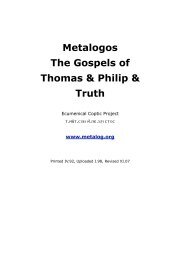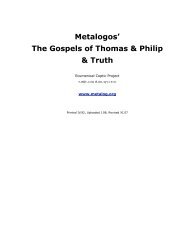Andrew Louth - Syriac Christian Church
Andrew Louth - Syriac Christian Church
Andrew Louth - Syriac Christian Church
You also want an ePaper? Increase the reach of your titles
YUMPU automatically turns print PDFs into web optimized ePapers that Google loves.
208 NOTES<br />
Faith 13 (Kotter [1973], 37). This definition of place ultimately derives<br />
from Aristotle, Physics IV.4.<br />
101 Maximus here and elsewhere (e.g. in sections 5 and 40) seems to use the<br />
third person singular imperfect of ‘to be’ (ên) in an absolute way to mean<br />
‘exists eternally’. I do not think this is a Neoplatonic usage— Plotinus<br />
regards eternity (let alone the One) as being beyond past and future<br />
tense, and characterized by an absolute use of the present tense (see<br />
Enneads III.7.3.34–6). It is, perhaps, a <strong>Christian</strong> usage, derived from<br />
John 1:1 (En archêi ên ho logos): Cyril of Alexandria, in his Commentary<br />
on St John’s Gospel, comments that ‘Used of God, the word “was”<br />
introduces the meaning of his absolute eternity, his being older than<br />
any temporal beginning, and removes the thought that he might be<br />
made’ (Book 1, c.7, on John 1:6f.: Pusey [1872], I.91, II. 5–8). It is also<br />
found in the scholia on the Corpus Areopagiticum, ascribed to Maximus<br />
(many of which are, however, by John of Scythopolis): on Divine Names<br />
5.8 (which explains how tenses apply to God), we read: ‘“He was”, and<br />
what is understood to be included in this, agrees with nothing else than<br />
God, because “he was”, considered as anterior to every beginning’ (PG 4.<br />
328A8–11), which is very close to Cyril, but not actually a citation: see<br />
also 316BC where the use of ên is justified specifically in relation to<br />
John 1:1, though it is not explained there what it means.<br />
102 Cf. Denys the Areopagite, Divine Names V.8:824A.<br />
103 From here to the end of the section Maximus engages in a complicated<br />
argument against the possibility of uncreated matter which, he argues,<br />
would possess being from itself, but not form: out of which he constructs<br />
a reductio ad absurdum.<br />
104 See n. 101, above.<br />
105 This way of speaking of an ultimate unity (the monad) and an ultimate<br />
duality (the dyad), according to Maximus derived from the monad, goes<br />
back to Pythagoras, and was current in Neoplatonic circles (influenced,<br />
as they were, by the second-century revival of Pythagoreanism).<br />
106 The text in Migne marks no division here. This is taken from Eriugena’s<br />
version.<br />
107 For this triad (ousia, dynamis, energeia) of Neoplatonic inspiration, see:<br />
lamblichus, On the Mysteries of Egypt II.1; Proclus, Elements of<br />
Theology 169; Denys the Areopagite, Celestial Hierarchy XI.2, Divine<br />
Names IV.1, 23. See also Sherwood (1955a), 103–16.<br />
108 Denys the Areopagite, On the Divine Names, 13.3. I have assimilated<br />
the text given in Migne to the text of the new critical edition: Suchla<br />
(1990), 229.<br />
109 See Denys the Areopagite, On the Divine Names, 4.4 (Suchla [1990], 148,<br />
l.15): ‘as each to its own goal’ is, in fact, an exact citation.<br />
110 The material in this section is mainly drawn from Nemesius, On human<br />
nature 42–4. John Damascene also draws on these chapters from<br />
Nemesius (apparently quite independently of Maximus) in his<br />
discussion of providence in Exposition of the Faith 43.




